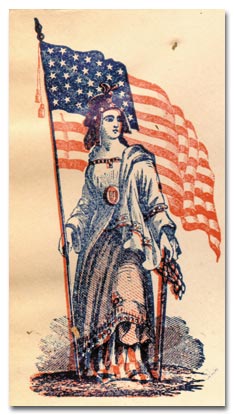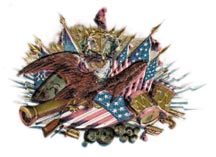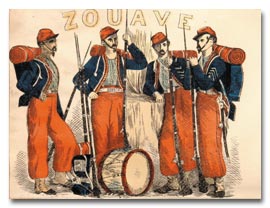The Civil War: Civil-War-era envelopes open a window to popular literature and patriotic culture
By Mark V. Wetherington, Ph.D.
Director
About |
 Soldiers as well as members of their families not only expressed their feelings about patriotism and the war’s purpose in written words but also in their choice of the envelopes (or “covers”) that carried letters home to family and friends. Envelopes were adorned with artwork, slogans, and short poems.
Soldiers as well as members of their families not only expressed their feelings about patriotism and the war’s purpose in written words but also in their choice of the envelopes (or “covers”) that carried letters home to family and friends. Envelopes were adorned with artwork, slogans, and short poems.
The Filson’s recent acquisition of a large collection of Civil-War-era envelopes, most of them produced in the North and in color, provides us with over 1,000 images of a new patriotic culture. Sending and collecting patriotic envelopes became a “craze” in 1861 and 1862 among both soldiers and civilians, representing an important part of the war’s early print culture. Commercial printers north and south offered hundreds of envelope designs, which in some cases became so elaborate that their entire front was covered, making them impossible to mail.
Flags were by far the most popular patriotic images printed on envelopes. In the North, the U. S. flag and references to it—on sails, shields, and streamers—appeared repeatedly, often accompanied by familiar-sounding patriotic slogans like “Colors That Won’t Run!” and “Stand by the Flag.” Northern vendors also offered envelopes carrying the flags of Confederate states but with a twist, blasting them as the symbols of treason. South Carolina’s Palmetto Flag, for instance, was printed with these words beneath: “The Black Flag and Trouble Maker of the Union.”
References to the Revolutionary War were also popular. Soldiers on both sides believed they were fighting to save the revolutionary heritage of the Founding Fathers and to preserve the liberty and freedom for their nations. George Washington’s face appeared on envelopes carrying the names of every state in the old Union, with such words as “The Legacy of our Fathers.” Thus, preservation of the Union, the North’s war aim early in the conflict, repeatedly appeared as a major theme both in images and in words like “OUR UNION Right or Wrong.”
 The important role of women in the war— as soldiers’ mothers and wives, as symbols of homefront domesticity, and as touchstones of male patriotism—was also featured on patriotic envelopes. Women were critical links between the battlefront and
homefront, in their willingness to urge men to fight for the cause, to support them at home with their own labors, and to sacrifice them for a greater good if necessary. Images of women as symbols of nationalism and patriotism appeared repeatedly in the form of Columbia (“Lady Liberty”), with either the U. S. flag or an uplifted sword in one hand, or both. In many cases, women were used as state symbols. In 1861, Kentucky was portrayed as a woman, with the “Secession wolf” on his knees, arms outstretched, romantically imploring her to secede with him.
The important role of women in the war— as soldiers’ mothers and wives, as symbols of homefront domesticity, and as touchstones of male patriotism—was also featured on patriotic envelopes. Women were critical links between the battlefront and
homefront, in their willingness to urge men to fight for the cause, to support them at home with their own labors, and to sacrifice them for a greater good if necessary. Images of women as symbols of nationalism and patriotism appeared repeatedly in the form of Columbia (“Lady Liberty”), with either the U. S. flag or an uplifted sword in one hand, or both. In many cases, women were used as state symbols. In 1861, Kentucky was portrayed as a woman, with the “Secession wolf” on his knees, arms outstretched, romantically imploring her to secede with him.
But ordinary women, too, played a significant role supporting the troops. One image depicts a woman making bread at home. “If I cannot fight, I can feed those who do,” the caption reads. On one envelope, a woman seated beneath a Union flag sews a jacket with these words printed below: “Our hearts are with our brothers in the field.” In another, a wife and child bid farewell to their volunteer in an image entitled “Change Arms!” The soldier leaves the arms of his loved ones and takes up “The New Minnie,” the rifle he holds in one hand.
 Because slavery played a central role in secession and the war, with emancipation joining the Union’s preservation as the major northern war aims, race and images of enslaved and freed African-Americans were frequently found on envelopes. Union envelopes, for example, depicted slaves as “The Innocent Cause of the War.” More often, however, blacks were portrayed as “contraband” of war, escaped or liberated slaves under the control of Union forces and no longer subject to slaveholders’ authority. On envelope fronts, runaways thumbed their noses at masters, declared themselves “contraband,” and fled to Union encampments.
Because slavery played a central role in secession and the war, with emancipation joining the Union’s preservation as the major northern war aims, race and images of enslaved and freed African-Americans were frequently found on envelopes. Union envelopes, for example, depicted slaves as “The Innocent Cause of the War.” More often, however, blacks were portrayed as “contraband” of war, escaped or liberated slaves under the control of Union forces and no longer subject to slaveholders’ authority. On envelope fronts, runaways thumbed their noses at masters, declared themselves “contraband,” and fled to Union encampments.
The Filson’s fine Civil War collections—including diaries, letters, photographs, and sheet music—has now grown to include hundreds of envelope images representing the war’s patriotic culture. These envelope designs drew upon nationalism, sectionalism, popular literature, stereotypes, and Victorian sentimentality in a collective effort to mobilize men, women, and children behind the cause.
The Filson Historical Society
1310 South Third Street - Louisville, KY
40208
Phone: (502) 635-5083 Fax: (502) 635-5086
Hours
The Ferguson Mansion and Office
Monday - Friday: 9 am. - 5 pm.
Saturday and Sunday closed
Library
Monday - Friday: 9 am. - 5 pm.
Saturday: 9 am. - 12 noon
